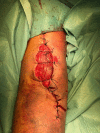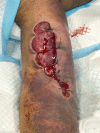Crimean-Congo haemorrhagic fever presenting with acute compartment syndrome of the extremities (think beyond normal infections)
- PMID: 32033997
- PMCID: PMC7021107
- DOI: 10.1136/bcr-2019-232323
Crimean-Congo haemorrhagic fever presenting with acute compartment syndrome of the extremities (think beyond normal infections)
Abstract
Crimean-Congo haemorrhagic fever (CCHF) is a viral zoonosis transmitted to humans and animals (which act as a reservoir) through the bite of a 'Hyalomma' tick. CCHF virus belongs to the genus Nairovirus Humans are infected when they come in direct contact with the blood or secretions of infected livestock or other infected humans. This disease initially presents with non-specific febrile symptoms common to many viral illnesses and later progresses to disseminated intravascular coagulation (DIC) with haemorrhagic manifestations.We present the case of a middle-aged man with CCHF. He presented to the hospital with DIC and acute compartment syndrome in the right forearm, requiring urgent orthopaedic intervention. The diagnosis was delayed because there was no clear history of contact. The patient was started taking ribavirin on the fifth day of hospital admission. He recovered fully.
Keywords: infectious diseases; surgery.
© BMJ Publishing Group Limited 2020. No commercial re-use. See rights and permissions. Published by BMJ.
Conflict of interest statement
Competing interests: None declared.
Figures



Similar articles
-
[Two Crimean-Congo hemorrhagic fever cases without history of tick contact from Ankara region].Mikrobiyol Bul. 2009 Oct;43(4):677-81. Mikrobiyol Bul. 2009. PMID: 20084924 Turkish.
-
Crimean-Congo hemorrhagic fever virus in livestock ticks and animal handler seroprevalence at an abattoir in Ghana.BMC Infect Dis. 2016 Jul 8;16:324. doi: 10.1186/s12879-016-1660-6. BMC Infect Dis. 2016. PMID: 27392037 Free PMC article.
-
Severe Crimean-Congo haemorrhagic fever presented with massive retroperitoneal haemorrhage that recovered without antiviral treatment.BMJ Case Rep. 2011 Aug 19;2011:bcr1020103408. doi: 10.1136/bcr.10.2010.3408. BMJ Case Rep. 2011. PMID: 22678739 Free PMC article.
-
Crimean-Congo Hemorrhagic Fever.Lab Med. 2015 Summer;46(3):180-9. doi: 10.1309/LMN1P2FRZ7BKZSCO. Lab Med. 2015. PMID: 26199256 Review.
-
[Crimean-Congo hemorrhagic fever: basics for general practitioners].Med Trop (Mars). 2010 Dec;70(5-6):429-38. Med Trop (Mars). 2010. PMID: 21520641 Review. French.
References
-
- Lacy MD, Smego RA. Viral hemorrhagic fevers. Adv Pediatr Infect Dis 1996;12:21–53. - PubMed
Publication types
MeSH terms
LinkOut - more resources
Full Text Sources
